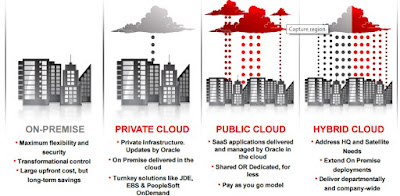Cloud ERP is an approach to enterprise resource planning (ERP) that makes use of cloud computing platforms and services to provide a business with more flexible business process transformation.
Oracle Cloud is the industry's broadest and most integrated public cloud, offering best-in-class services across software as a service (SaaS), platform as a service (PaaS), infrastructure as a service (IaaS), and data as a service (DaaS).
Choice of Deployment:
Multi Tenant or Single Tenant Cloud:
Multi-tenant Software as a Service (SaaS) is an architecture where multiple companies share the same instance to store their data. Multi-tenancy means that a single instance of the software and all of the supporting infrastructure serves multiple customers. Each customer shares the software application and also shares a single database. The data is tagged in the database as belonging to one customer or another, and the software is smart enough to know who the data belongs to.
Single-tenant (or hosted) Software as a Service (SaaS) is an architecture where each company has their own instance of the software application and supporting infrastructure
A single instance of the software and all of the supporting infrastructure serves a single customer. With single tenancy, each customer has their own independent database and instance of the software. With this option, there’s essentially no sharing going on. Everyone has their own, separate from everyone else.
In Oracle Database 12c, Multitenant is a pure deployment choice. It is possible to upgrade from, say, Oracle Database 11g to Oracle Database 12c, non-CDB and stop there. The next step and adopt that database as a PDB by plugging it into a CDB ( Container database) . Note that if that is the only PDB (Pluggable databases) plugged into the CDB this is what we call the single tenant configuration (using the multitenant architecture). The single tenant configuration does not require nor trigger the Multitenant licensed option.
Oracle Database 12c you have three choices:
Reference: Oracle.com
Oracle Cloud is the industry's broadest and most integrated public cloud, offering best-in-class services across software as a service (SaaS), platform as a service (PaaS), infrastructure as a service (IaaS), and data as a service (DaaS).
Choice of Deployment:
Multi Tenant or Single Tenant Cloud:
Multi-tenant Software as a Service (SaaS) is an architecture where multiple companies share the same instance to store their data. Multi-tenancy means that a single instance of the software and all of the supporting infrastructure serves multiple customers. Each customer shares the software application and also shares a single database. The data is tagged in the database as belonging to one customer or another, and the software is smart enough to know who the data belongs to.
Single-tenant (or hosted) Software as a Service (SaaS) is an architecture where each company has their own instance of the software application and supporting infrastructure
A single instance of the software and all of the supporting infrastructure serves a single customer. With single tenancy, each customer has their own independent database and instance of the software. With this option, there’s essentially no sharing going on. Everyone has their own, separate from everyone else.
In Oracle Database 12c, Multitenant is a pure deployment choice. It is possible to upgrade from, say, Oracle Database 11g to Oracle Database 12c, non-CDB and stop there. The next step and adopt that database as a PDB by plugging it into a CDB ( Container database) . Note that if that is the only PDB (Pluggable databases) plugged into the CDB this is what we call the single tenant configuration (using the multitenant architecture). The single tenant configuration does not require nor trigger the Multitenant licensed option.
Oracle Database 12c you have three choices:
- Non-CDB (the old architecture).
- Multitenant architecture in single tenant configuration (one PDB per CDB). No license required.
- Multitenant architecture with multiple PDBs per CDB. Requires licensed option but of course you can manage many as one and get all the other benefits.
Reference: Oracle.com





